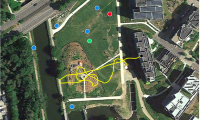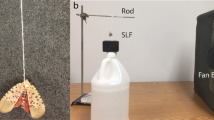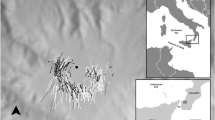Alates of the Eastern subterranean termite, Reticulitermes flavipes (Kollar) were collected over two flight seasons (2002 and 2004) and flown on flight mills. Data were collected to test if alate mass, colony origin, or gender influenced flight speed. Flight speed ranged from 3.14 to 69.12 cm s−1 and the maximum distance flown by an alate was 458.3 m. Alate mass (P = 0.9406), gender (P = 0.3976), colony origin (P = 0.1244), and the interaction of gender and colony (P = 0.7093) did not significantly influence flight speed. Additionally, an electronic counting device was used to provide instantaneous flight speeds and allowed flight speed to be modeled during acceleration, cruising, and deceleration periods of flight. Mean (±SEM) flight speeds in 2004 were 20.64 (±2.21) cm s−1 (n = 13) for males and 17.76 cm s−1 (n = 1) for the single female flown, falling within the range of the 2002 values.





Similar content being viewed by others
REFERENCES
Atkinson, L., and Adams, E. S. (1997). The origins and relatedness of multiple reproductives in colonies of the termite Nasutitermes corniger. Proc. R. Soc. Lond. B 264: 1131–1136.
Beenakkers, A. M. T. (1969). Carbohydrate and fat as a fuel for insect flight. A comparative study. J. Insect Physiol. 15: 353–361.
Campora, C. E., and Grace, J. K. (2004). Effect of average worker size on tunneling behavior of Formosan subterranean termite colonies. J. Insect Behav. 17: 777–791.
Grace, J. K. (1996). Temporal and spatial variation in caste proportions in a northern Reticulitermes flavipes colony (Isoptera: Rhinotermitidae). Sociobiology 28: 225–231.
Haverty, M. I., Getty, G. M., Nelson, L. J., and Lewis, V. R. (2003). Flight phenology of sympatric populations of Reticulitermes (Isoptera: Rhinotermitidae) in northern California: Disparate flight intervals indicate reproductive isolation among cuticular hydrocarbon phenotypes. Ann. Entomol. Soc. Am. 96: 828–833.
Hostettler, N. C., Hall, D. W., and Scheffrahn, R. H. (1995). Intracolony morphometric variation and labral shape in Florida Reticulitermes (Isoptera: Rhinotermitidae) soldiers: Significance for identification. Florida Entomol. 78: 119–129.
Husseneder, C., and Grace, J. K. (2001a). Evaluation of DNA fingerprinting, aggression tests, and morphometry as tools for colony delineation of the Formosan subterranean termite. J. Insect Behav. 14: 173–186.
Husseneder, C., and Grace, J. K. (2001b). Similarity is relative: Hierarchy of genetic similarities in the Formosan subterranean termite (Isoptera: Rhinotermitidae) in Hawaii. Environ. Entomol. 30: 262–266.
Jenkins, T. M., Dean, R. E., Verkerk, R., and Forschler, B. T. (2001). Phylogenetic analyses of two mitochondrial genes and one nuclear intron region illuminate European subterranean termite (Isoptera: Rhinotermitidae) gene flow, taxonomy, and introduction dynamics. Mol. Phylogenet. Evol. 20: 286–293.
Kofoid, C. A. (1934). Termites and Termite Control, University of California Press, Berkeley.
Lainé, L. V., and Wright, D. J. (2003). The life cycle of Reticulitermes spp. (Isoptera: Rhinotermitidae) what do we know? Bull. Entomol. Res. 93: 267–278.
Leong, K. L. H., Tamashiro, M., Yates, J. R., III, and Su, N.-Y. (1983). Microenvironmental factors regulating the flight of Coptotermes formosanus Shiraki in Hawaii (Isoptera: Rhinotermitidae). Proc. Hawaiian Entomol. Soc. 24: 287–291.
Minitab, Inc. (2003). Meet Minitab, Release 14 for Windows, Minitab, Inc., State College.
Montgomery, D. C., and Peck, E. A. (1982). Introduction to Linear Regression Analysis, Wiley, New York.
Nutting, W. L. (1969). Flight and colony foundation. In Krishna, K., and Weesner, F. M. (eds.), Biology of Termites, Vol. 1, Academic Press, New York, pp. 233–282.
Nutting, W. L. (1979). Termite flight periods: Strategies for predator avoidance? Sociobiology 42: 141–151.
Osbrink, W. L. A., and Lax, A. R. (2002). Effect of tolerance to insecticides on substrate penetration by Formosan subterranean termites (Isoptera: Rhinotermitidae). J. Econ. Entomol. 95: 989–1000.
Sacktor, B. (1974). Biological oxidations and energetics in insect mitochondria. In Rockstein, M. (ed.), Physiology of Insecta, Academic Press, New York, pp. 272–355.
SAS Institute, Inc. (2001). SAS User's Guide: Statistics, SAS Institute, Inc., Cary, NC.
Scheffrahn, R. H., and Su, N.-Y. (1994). Keys to soldier and winged adult termites (Isoptera) of Florida. Florida Entomol. 77: 460–474.
Shelton, T. G., and Appel, A. G. (2001a). Cyclic CO2 release and water loss in alates of the Eastern subterranean termite (Isoptera: Rhinotermitidae). Ann. Entomol. Soc. Am. 94: 420–426.
Shelton, T. G., and Appel, A. G. (2001b). Carbon dioxide release in Coptotermes formosanus Shiraki and Reticulitermes flavipes (Kollar): Effects of caste, mass, and movement. J. Insect Physiol. 47: 213–224.
Shelton, T. G., and Grace, J. K. (1996). Review of agonistic behaviors in the Isoptera. Sociobiology 28: 155–176.
Shelton, T. G., and Grace, J. K. (2003). Cuticular permeability of two species of Coptotermes Wasmann (Isoptera: Rhinotermitidae). Comp. Physiol. Biochem. A 134: 205–211.
Su, N.-Y., and Haverty, M. I. (1991). Agonistic behavior among colonies of the Formosan subterranean termite, Coptotermes formosanus Shiraki (Isoptera: Rhinotermitidae), from Florida and Hawaii: Lack of correlation with cuticular hydrocarbon composition. J. Insect Behav. 4: 115–128.
Thorne, B. L. (1983). Alate production and sex ratio in colonies of the neotropical termite Nasutitermes corniger (Isoptera: Termitidae). Oecologia 58: 103–109.
Thorne, B. L. (1984). Polygyny in the neotropical termite Nasutitermes corniger: Life history consequences of queen mutualism. Behav. Ecol. Sociobiol. 14: 117–136.
Thorne, B. L. (1996). Termite terminology. Sociobiology 28: 253–261.
Thorne, B. L., and Haverty, M. I. (1991). A review of intracolony, intraspecific, and interspecific agonism in termites. Sociobiology 19: 115–145.
Thorne, B. L., Traniello, J. F. A., Adams, E. S., and Bulmer, M. (1999). Reproductive dynamics and colony structure of subterranean termites of the genus Reticulitermes (Isoptera: Rhinotermitidae): A review of the evidence from behavioral, ecological, and genetic studies. Ethol. Ecol. Evol. 11: 149–169.
Vargo, E. L. (2003). Hierarchical analysis of colony and population genetic structure of the Eastern subterranean termite, Reticulitermes flavipes, using two classes of molecular markers. Evolution 57: 2805–2818.
Vieau, F. (2001). Comparison of the spatial distribution and reproductive cycle of Reticulitermes santonensis Feytaud and Reticulitermes lucifugus grassei Clément (Isoptera, Rhinotermitidae) suggests that they represent introduced and native species, respectively. Insect Soc. 48: 57–62.
ACKNOWLEDGMENTS
The authors thank M. J. Tanley and Yongyu Xu for expert technical assistance during the course of these studies. Thanks are also given to Dunlun Song and Xueyou Hu for their assistance in alate collections during the 2004 studies. The assistance of J. R. B. Lighton, B. Joos, and R. Turner in constructing the flight mill speed device is greatly appreciated. The input of two anonymous reviewers, as well as J. K. Grace (University of Hawaii), P. D. Gerard (Mississippi State University), and J. E. Mulrooney (USDA Forest Service) in improving earlier drafts of this manuscript is appreciated. These studies were supported in part by USDA Forest Service agreement SRS 02-CR-11330130-212 with the Department of Entomology & Plant Pathology at Auburn University.
Author information
Authors and Affiliations
Corresponding author
Rights and permissions
About this article
Cite this article
Shelton, T.G., Hu, X.P., Appel, A.G. et al. Flight Speed of Tethered Reticulitermes flavipes (Kollar) (Isoptera: Rhinotermitidae) Alates. J Insect Behav 19, 115–128 (2006). https://doi.org/10.1007/s10905-005-9012-1
Revised:
Accepted:
Published:
Issue Date:
DOI: https://doi.org/10.1007/s10905-005-9012-1




